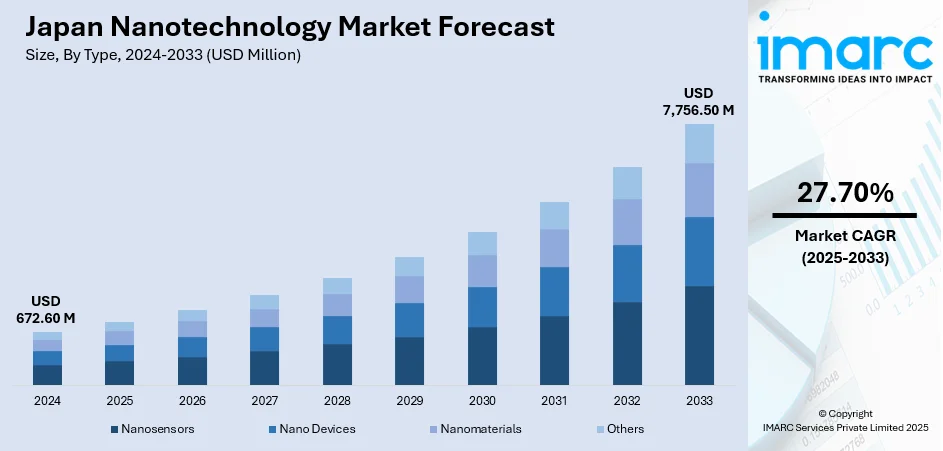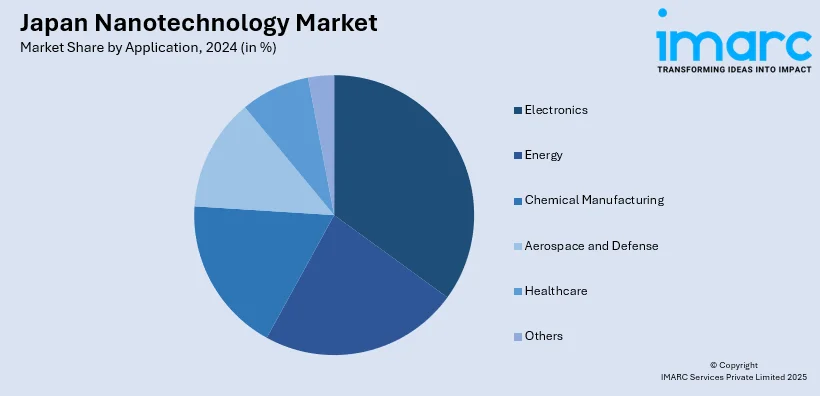
Japan Nanotechnology Market Size, Share, Trends, and Forecast by Type, Application, and Region, 2025-2033
Japan Nanotechnology Market Overview:
The Japan nanotechnology market size reached USD 672.60 Million in 2024. Looking forward, IMARC Group expects the market to reach USD 7,756.50 Million by 2033, exhibiting a growth rate (CAGR) of 27.70% during 2025-2033. The market is propelled by high government encouragement of research and development, fast developments in material science, and increasing applications in numerous industries like electronics, healthcare, and manufacturing. These are all fueling the growing Japan nanotechnology market share to become a leading global innovator.
|
Report Attribute
|
Key Statistics
|
|---|---|
|
Base Year
|
2024
|
|
Forecast Years
|
2025-2033
|
|
Historical Years
|
2019-2024
|
| Market Size in 2024 | USD 672.60 Million |
| Market Forecast in 2033 | USD 7,756.50 Million |
| Market Growth Rate 2025-2033 | 27.70% |
Japan Nanotechnology Market Trends:
Advancements in Healthcare and Drug Delivery Systems
Its uses in healthcare are fueling the growth of the Japanese nanotechnology market. Nanotechnology is revolutionizing drug delivery systems such that drugs are delivered more precisely with fewer side effects and greater therapeutic efficacy. Japan is at the forefront of developing nanoparticles and nanomaterials for targeted drug delivery, particularly cancer treatment. Japanese firms are employing nanocarriers and liposomes to enhance the solubility and bioavailability of drugs, leading to improved treatments. Besides, Japan's shrinking population is pushing the demand for innovative medical technologies, and nanotechnology can fulfill the demand by making the healthcare solutions more efficient and more targeted, placing Japan in the lead in nanomedicine. For instance, in April 2025, two scientists from Canada and Japan were honored at the 47th King Faisal Prize ceremony. The Medicine Prize recognized groundbreaking advancements in CAR T-cell therapy, revolutionizing cancer treatment, while the Science Prize celebrated the discovery of carbon nanotubes, a key development in nanotechnology. These achievements have transformed cancer therapy, materials science, and medicine.

To get more information on this market, Request Sample
Innovation in Electronics and Semiconductor Manufacturing
The growing demand for smaller, faster, and more energy-efficient electronic devices is propelling the Japan nanotechnology market growth. Japanese firms are employing nanomaterials such as carbon nanotubes and nanowires to improve semiconductors and electronic devices. These materials allow for the creation of smaller, faster chips, needed in the newest consumer electronics innovations, such as smartphones, wearable technology, and computers. Japan's powerful semiconductor sector is rapidly embracing nanotechnology to meet miniaturization and performance needs, providing it with a competitive advantage in the international electronics marketplace. This industry's ongoing advancement will propel Japan's dominance of the international nanotechnology market. For instance, in January 2025, NIMS exhibited at nano tech 2025, the 24th International Nanotechnology Exhibition & Conference at Tokyo Big Sight. The event showcased NIMS & MEXT initiatives, featuring presentations on innovative technologies, including magnetic refrigerators, next-gen cooling systems, and hydrogen production. NIMS also presented cutting-edge research on materials science, energy, and nanotechnology. The National Institute for Materials Science (NIMS) is a leading research organization in Japan, known for its advancements in materials science, energy storage, electronics, and nanotechnology.
Japan Nanotechnology Market Segmentation:
IMARC Group provides an analysis of the key trends in each segment of the market, along with forecasts at the country/regional level for 2025-2033. Our report has categorized the market based on type and application.
Type Insights:
- Nanosensors
- Nano Devices
- Nanomaterials
- Others
The report has provided a detailed breakup and analysis of the market based on the type. This includes nanosensors, nano devices, nanomaterials, and others.
Application Insights:

- Electronics
- Energy
- Chemical Manufacturing
- Aerospace and Defense
- Healthcare
- Others
A detailed breakup and analysis of the market based on the application have also been provided in the report. This includes electronics, energy, chemical manufacturing, aerospace and defense, healthcare, and others.
Regional Insights:
- Kanto Region
- Kansai/Kinki Region
- Central/Chubu Region
- Kyushu-Okinawa Region
- Tohoku Region
- Chugoku Region
- Hokkaido Region
- Shikoku Region
The report has also provided a comprehensive analysis of all the major regional markets, which include Kanto Region, Kansai/Kinki Region, Central/Chubu Region, Kyushu-Okinawa Region, Tohoku Region, Chugoku Region, Hokkaido Region, and Shikoku Region.
Competitive Landscape:
The market research report has also provided a comprehensive analysis of the competitive landscape. Competitive analysis such as market structure, key player positioning, top winning strategies, competitive dashboard, and company evaluation quadrant has been covered in the report. Also, detailed profiles of all major companies have been provided.
Japan Nanotechnology Market News:
- In May 2025, researchers from the Institute of Science Tokyo developed a large, hollow dodecahedral metal-peptide nanostructure through self-assembly. The 6.3-nanometer structure, created using geometric principles from knot and graph theory, features a stable inner cavity capable of encapsulating macromolecules. This advancement in molecular engineering opens doors for creating complex artificial virus capsids. The structure's stability and modifiability make it a promising platform for applications in drug delivery, molecular transportation, and materials chemistry.
- In March 2025, Nippon Paint and Uchihamakasei Corp. pioneered Japan’s first in-mold coating (IMC) technology for large thermoplastic automotive parts, utilizing nanotechnology principles to enhance precision and sustainability. This innovative process merges molding and coating into one step, significantly reducing CO₂ emissions by 60% and eliminating VOC emissions. By applying advanced solvent-free nanomaterials, the technology enables ultra-smooth, high-quality coatings with intricate design capabilities, such as structural color and fine textures at the nanoscale. This breakthrough technology paves the way for eco-friendly, high-performance automotive coatings while advancing carbon-neutral manufacturing processes.
Japan Nanotechnology Market Report Coverage:
| Report Features | Details |
|---|---|
| Base Year of the Analysis | 2024 |
| Historical Period | 2019-2024 |
| Forecast Period | 2025-2033 |
| Units | Million USD |
| Scope of the Report |
Exploration of Historical Trends and Market Outlook, Industry Catalysts and Challenges, Segment-Wise Historical and Future Market Assessment:
|
| Types Covered | Nanosensor, Nano Devices, Nanomaterials, Others |
| Applications Covered | Electronics, Energy, Chemical Manufacturing, Aerospace and Defense, Healthcare, Others |
| Regions Covered | Kanto Region, Kansai/Kinki Region, Central/Chubu Region, Kyushu-Okinawa Region, Tohoku Region, Chugoku Region, Hokkaido Region, Shikoku Region |
| Customization Scope | 10% Free Customization |
| Post-Sale Analyst Support | 10-12 Weeks |
| Delivery Format | PDF and Excel through Email (We can also provide the editable version of the report in PPT/Word format on special request) |
Key Questions Answered in This Report:
- How has the Japan nanotechnology market performed so far and how will it perform in the coming years?
- What is the breakup of the Japan nanotechnology market on the basis of type?
- What is the breakup of the Japan nanotechnology market on the basis of application?
- What is the breakup of the Japan nanotechnology market on the basis of region?
- What are the various stages in the value chain of the Japan nanotechnology market?
- What are the key driving factors and challenges in the Japan nanotechnology market?
- What is the structure of the Japan nanotechnology market and who are the key players?
- What is the degree of competition in the Japan nanotechnology market?
Key Benefits for Stakeholders:
- IMARC’s industry report offers a comprehensive quantitative analysis of various market segments, historical and current market trends, market forecasts, and dynamics of the Japan nanotechnology market from 2019-2033.
- The research report provides the latest information on the market drivers, challenges, and opportunities in the Japan nanotechnology market.
- Porter's five forces analysis assist stakeholders in assessing the impact of new entrants, competitive rivalry, supplier power, buyer power, and the threat of substitution. It helps stakeholders to analyze the level of competition within the Japan nanotechnology industry and its attractiveness.
- Competitive landscape allows stakeholders to understand their competitive environment and provides an insight into the current positions of key players in the market.
Need more help?
- Speak to our experienced analysts for insights on the current market scenarios.
- Include additional segments and countries to customize the report as per your requirement.
- Gain an unparalleled competitive advantage in your domain by understanding how to utilize the report and positively impacting your operations and revenue.
- For further assistance, please connect with our analysts.
 Request Customization
Request Customization
 Speak to an Analyst
Speak to an Analyst
 Request Brochure
Request Brochure
 Inquire Before Buying
Inquire Before Buying




.webp)




.webp)












